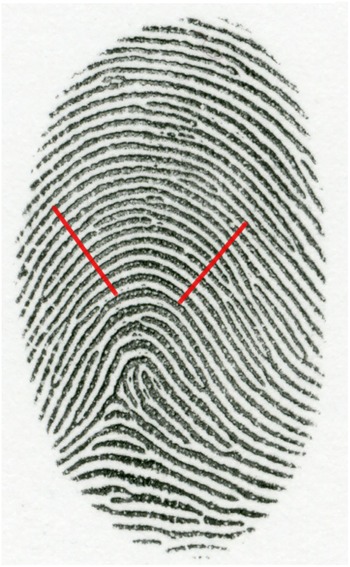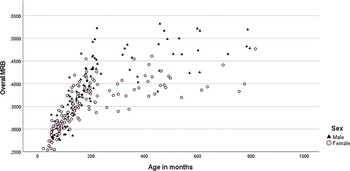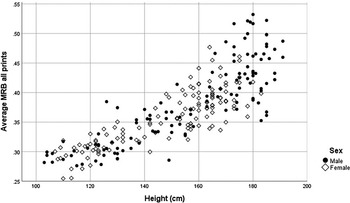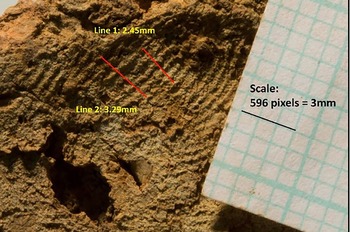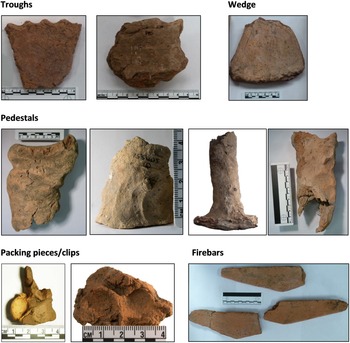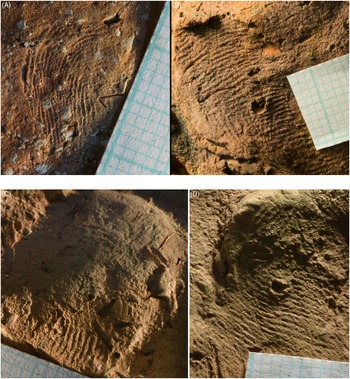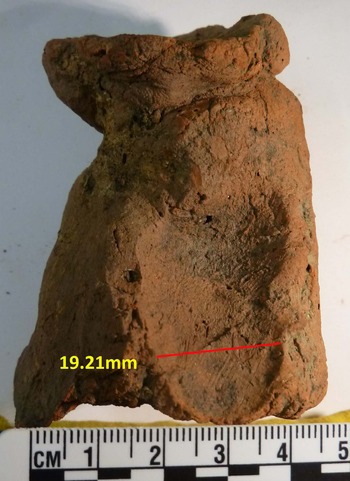Fingerprints are sometimes preserved in the surface of clay and their potential to provide information about the people involved in making the artefacts has been recognised for some time (Primas Reference Primas1975; Kamp et al. Reference Kamp, Timmerman, Lind, Greybill and Natowsky1999; Králík & Novotný Reference Králík and Novotny2003; Hruby Reference Hruby and Brysbaert2011; Sanders Reference Sanders2015; Zadeh Reference Zadeh2017; Blaževičius Reference Blaževičius2019; Fowler et al. Reference Fowler, Walker, Greenfield, Ross and Aren2019; Reference Fowler, Ross, Walker, Barritt-Cleary, Greenfield and Aren.2020). However, to date little work has been carried out applying techniques of fingerprint analysis to British prehistoric material. This article reports on the development of a technique tailored to later prehistoric material and its application to assemblages of ceramic material associated with salt extraction activities during the Iron Age. The scale and widespread nature of salt production attests to its value to later prehistoric societies across Europe and further afield. The utilitarian nature of ceramics employed in the processes of boiling brine to extract salt crystals lends itself to the accidental preservation of fingerprints (and sometimes impressions of whole fingertips), which presents an opportunity to explore who was involved in production of this valuable resource. The methods described herein are applicable beyond the case study assemblages to a wide range of ceramic artefacts and, with adaptations, to fingerprints preserved in other materials.
Analysing fingerprints allows insights into the demographic constitution of communities of practice, namely groups of people united by an interest or a craft and who share and deepen their knowledge of it by continual interaction, developing over time a body of common knowledge, practices, and approaches (Lave & Wenger Reference Lave and Wenger1991; Wenger et al. Reference Wenger, McDermott and Snyder2002). In the context of this research, communities of practice are those social networks in which the salt makers shared a technological tradition involving the manufacture of briquetage and the extraction of salt from sea water. This article explores the question of who made up communities of salt makers, focusing on evidence from Iron Age coastal salt working sites in eastern England.
FINGERPRINTS
The visible lines on the skin of the fingertips are known as epidermal ridges. Each person’s ridge pattern (comprising a central arch, whorl or loop, and surrounding lines with macro-features and ridge minutiae) is unique and develops in utero, being complete before birth (Gowland & Thompson Reference Gowland and Thompson2013). Once formed, fingerprint patterns do not change. Ridge number and pattern are independent of age and ridges increase in size rather than number as the fingers grow. Once an individual reaches maturity, epidermal ridge characteristics are not affected by increasing age or by environmental factors (Mundorff et al. Reference Mundorff, Bartelink and Murad2014).
Within geographically defined populations there is sexual dimorphism within the epidermal breadths of adult males and females, as well as differences in the mean ridge breadths between discrete populations (Acree Reference Acree1999; Gungadin Reference Gungadin2007; Gutiérrez-Redomero et al. Reference Gutiérrez-Redomero, Alonso, Romero and Galera2008; Reference Gutiérrez-Redomero, Alonso and Dipierri2011; Reference Gutiérrez-Redomero, Sánchez-Andrés, Rivaldería, Alonso-Rodrigues, Dipierri and Martín2013; Reference Gutiérrez-Redomero, Rivaldería, Alonso-Rodrigues and Sánchez-Andrés2014; Nayak Reference Nayak, Rastogi, Kanchan, Lobo, Yoganarasimha and Nayak2010a; Reference Nayak, Rastogi, Kanchan, Yoganarasimha, Pradeep Kumar and Menezes2010b; Nithin Reference Nithin, Nithin, Manjunatha, Preethi and Balaraj2011; Agnihotri Reference Agnihotri, Jowaheer and Allock2012; Eshak et al. Reference Eshak, Zaher, Hasan and El-Azeem Ewis2013; Krishan et al. Reference Krishan, Kanchan and Ngangom2013; Mundorff et al. Reference Mundorff, Bartelink and Murad2014).
METHODOLOGY
Given the known geographic differences in epidermal ridge measurements, it was considered important to use a reference dataset matching as closely as possible the archaeological population under study. The shortage of published studies of British or northern European populations and the lack of data for subadults meant that, to study fingerprints found on British prehistoric artefacts, it was necessary to create a modern reference dataset of fingerprints from the same broad area as that under study. This approach was also adopted by Zadeh (Reference Zadeh2017) who examined Bronze Age Austrian fingerprints using modern Austrian fingerprints as a comparator. It is acknowledged that population movements during and since the prehistoric period mean there is no certain correlation between modern and prehistoric prints but a broadly geographically matched modern data set provides the best source of reference material.
Approval was obtained from the Ethics Committee at the University of Leicester for the collection of inked fingerprints from participants and parental or guardian consent was obtained in relation to each participant under the age of 18. Inked fingerprints from all ten digits were collected from 256 participants aged 4 years to adult (Table 1). Ethnographic research has shown that children start to become involved in pottery production from age 5 (Crown Reference Crown2014), therefore 4 and 5 year olds were considered to be the youngest age group required for the study. Collection was restricted to Caucasian Europeans but not just British individuals, given that isotopic analysis has shown that many later prehistoric inhabitants of the British Isles had origins in continental Europe (Sheridan Reference Sheridan2008; Olalde et al. Reference Olalde, Brace, Allentoft, Armit, Kristiansen and Booth2018; Patterson et al. Reference Patterson, Isakov, Booth, Büster, Fischer and Olalde2021) and populations are not static.
Table 1. Age and Sex of Participants in Fingerprint Reference Collection

Inked fingerprints were scanned at 1200 dpi and the measurement tool in Adobe Photoshop CC was used to measure the epidermal ridges, calibrated by reference to 1 mm square graph paper fixed to each inked fingerprint recording form. Following Kamp et al. (Reference Kamp, Timmerman, Lind, Greybill and Natowsky1999), Mundorff et al. (Reference Mundorff, Bartelink and Murad2014), and Zadeh (Reference Zadeh2017), measurements were taken by drawing a line perpendicularly over a group of epidermal ridges starting at the beginning of an inked line representing a ridge and terminating with the edge of a furrow, thus giving measurements over a series of ridge and furrow sets. For each fingerprint, two lines were drawn at the distal end, perpendicularly across at least ten epidermal ridges, starting three or four ridges out from the centre, at approximately ‘10 to 2’ positions, providing measurements from both the radial and ulnar sides of the digit (Fig. 1). The distal region was used to avoid distortion from the central whorl or arch features of the prints and because informal observation of pottery making indicates people use the tips of their fingers more than the proximal area when shaping pottery.

Fig. 1. Inked fingerprint measurement technique
The edges of each print were avoided as the lines become less distinct due to the curvature of the fingertip away from the paper. Mean Ridge Breadth (MRB) was calculated by dividing the length of the line drawn over the ridges by their number. The two calculations were averaged to give an MRB for each digit. The digits were averaged to give an overall MRB for each individual. It is accepted that using the overall MRB for each participant masks the variation in MRB of individual digits. However, given that it will not be clear from a print left on pottery which digit made it, the overall MRB is considered a useful (if, by its nature, average) guide to the size of epidermal ridges of individuals. Month and year of birth, sex, and height were also recorded for each participant.
It is possible to use density of ridges in a defined area to infer sex of adult print makers (Sanders Reference Sanders2015; Fowler et al. Reference Fowler, Walker, Greenfield, Ross and Aren2019; Reference Fowler, Ross, Walker, Barritt-Cleary, Greenfield and Aren.2020, although Zadeh Reference Zadeh2017 argues it is unreliable) but as the primary focus of this study was age, MRB was the preferred measurement (Kamp et al. Reference Kamp, Timmerman, Lind, Greybill and Natowsky1999; Hruby Reference Hruby and Brysbaert2011; Zadeh Reference Zadeh2017; Blaževičius Reference Blaževičius2019).
Tests for inter- and intra-rater reliability were performed to check the robustness of the method when performed by different individuals and by the same individual on different days. Intra-class correlation coefficients were 0.849 for inter-rater and 0.992 for intra-rater tests, indicating the methods used to take measurements to create the reference collection were methodologically robust.
The relationship between age and overall MRB (Fig. 2) has a clear trend of increasing MRB with age until around 180–200 months. After this, the correlation is less evident and a broad pattern of sexual dimorphism emerges, with females generally (although not exclusively) having narrower MRBs than males. MRBs over 0.48 mm were exclusively from males over 16 years.

Fig. 2. Average MRB by age in months
There is also clear correlation between an individual’s height and their overall MRB (Fig. 3). The Pearson correlation coefficient for bivariate data (height and MRB) is 0.838, indicating strong correlation and thus the importance of considering height when interpreting MRB. Given the broad correlation between height and MRB, height should be translated into age using a knowledge of height variability in the population under study (Kamp et al. Reference Kamp, Timmerman, Lind, Greybill and Natowsky1999). Therefore, it is important to consider stature in the period to which specific archaeological fingerprints date.

Fig. 3. Average MRB and height
In the British Iron Age, stature, albeit from temporally and regionally limited inhumation burials, is reported as 168 cm for males and 162 cm for females (Roberts & Cox Reference Roberts and Cox2003), or 167 cm for males and 156 cm for females (Dent Reference Dent2010). Combining these provides an average height of 167.5 cm for adult males and 159 cm for adult females. The average height for adult males (18 years and over) in the modern reference collection was 180 cm and for adult females was 167 cm, respectively 12.5 cm and 8 cm taller than the Iron Age averages. Both are slightly higher than averages in published studies on adult height in the UK (Moody Reference Moody2013; NCD Risk Factor Collaboration 2016; Galofré-Vilà et al. Reference Galofré-Vilà, Hinde and Guntupalli2017; National Institute for Health and Care Excellence 2017) but this may be a result of the relatively small sample size or the socio-economic status of the participants. Prehistoric subadult heights are harder to gauge as we do not know the relationship between growth rates and chronological age for later British prehistoric populations. Subadult heights in the reference collection fall within the parameters of ‘UK90’ (a chart containing growth data for 25,000 white British children) which is considered reliable by a working party of the Royal College of Paediatrics and Child Health (Wright et al. Reference Wright, Booth, Buckler, Cameron, Cole, Healy, Hulse, Preece, Reilly and Williams2002; Cameron & Hawley Reference Cameron and Hawley2010).
The reference collection data and knowledge of average heights during the British Iron Age enable a series of parameters to be developed for interpretation of archaeological fingerprints. MRB is used to determine the height of the printmaker and then their age is determined based on a rescaling of height data to reflect changes in average height between the Iron Age and now.
As one cannot initially tell whether a male or female made a fingerprint, a uniform approach to rescaling to account for height difference was employed. The mean of the adult height differences (94.1%) was used to adjust the height profiles for all ages to be of potential applicability to Iron Age populations. This assumes that although average heights have changed since the Iron Age, the relationship between height and MRB has not changed significantly.
Based on the detailed data, and given the overlapping MRBs and age categories, a simplified set of broad demographic categories for interpreting fingerprints was devised (Table 2). Previous studies (eg, Kamp et al. Reference Kamp, Timmerman, Lind, Greybill and Natowsky1999; Kralik & Novotny Reference Králík and Novotny2003) have employed regression equations to provide an age from MRB but the data in the reference collection in this study does not demonstrate a clear enough link between MRB and age for the calculation of a regression equation (contra Kamp et al. Reference Kamp, Timmerman, Lind, Greybill and Natowsky1999, and Kralik & Novotny Reference Králík and Novotny2003). Instead, the data enable a series of parameters to be developed to enable interpretation of the archaeological fingerprints into broad demographic groups (Zadeh Reference Zadeh2017). This method can indicate with some confidence whether a print was made by a younger child or by males in their late teens or adulthood. The overlaps between adult female print dimensions and those of adolescents render confident interpretation of the middle range of MRBs difficult. Data from this study indicate MRBs under 0.324 mm are from children under 10 years and those over 0.5 mm are from adult males. This largely concurs with the conclusions of Králik and Novotný (Reference Králík and Novotny2003) and Fowler et al. (Reference Fowler, Ross, Walker, Barritt-Cleary, Greenfield and Aren.2020) who argue MRBs under 0.37 mm represent pre-pubescent children and those over 0.52 mm correlate to adult males, with a broad adolescent/adult group represented by MRBs between those figures.
Table 2. MRB and Interpretation for Iron Age Fingerprints

In developing a framework for interpreting archaeological fingerprints, the recommendation of Appleby et al. (Reference Appleby, Thomas and Buikstra2015) was adopted, namely the use of an adapted version of the Istanbul Protocol Manual on the Effective Investigation and Documentation of Torture and other Cruel, Inhuman or Degrading Treatment or Punishment (UNHMO 2004). The adapted version of Appleby’s recommendations applied herein is:
-
MRB consistent with coming from an individual of [a specified] height/age bracket, meaning the print could have been made by a person within that classification but could also come from an individual outside it;
-
MRB highly consistent with coming from an individual of [a specified] height/age bracket, meaning the print could have been made by a person within that classification and it is unlikely to have been made by someone else;
-
MRB typical of an individual of [a specified] height/age bracket, meaning the print dimensions are usually found within a certain height/age group although it is possible it was made by someone outside that group;
-
MRB diagnostic of [a specified] height/age bracket meaning the print could only have some from someone within the specified group.
RECORDING ARCHAEOLOGICAL FINGERPRINTS
Clear, undistorted prints were photographed using a digital SLR camera with macro-lens, with the fingerprint positioned parallel to the camera lens. An oblique light source at c. 45° provided raking light across the surface and highlighted the ridges and furrows. To provide an accurate scale, a small piece of 1 mm graph paper was positioned on or adjacent to the fingerprint surface.
Using the same approach as used to measure the inked fingerprints, photographs were processed in Adobe Photoshop CC, in which the measurement tool was set by reference to the 1 mm graph paper. Measurements were taken perpendicularly across several ridges, with the line length divided by the number of ridges to determine MRB (Fig. 4). Two or three lines per print were measured and an average calculated. Given the partial nature of most of the fingerprints, this approach is considered the most feasible to use with archaeological specimens (Kamp et al. Reference Kamp, Timmerman, Lind, Greybill and Natowsky1999; Králik & Novotný Reference Králík and Novotny2003; Mundorff et al. Reference Mundorff, Bartelink and Murad2014; Zadeh Reference Zadeh2017), and replicates that used for the inked prints.

Fig. 4. Fingerprint measurement technique
CLAY SHRINKAGE
It is important to account for clay shrinkage when analysing the measurements of epidermal ridges recorded on pottery so that measurements can be rescaled to living dimensions. It is generally accepted that clay shrinks by between 2% and 9%, depending on its water content, mineral composition, and the firing environment. A working average of 7.5% used by fingerprint researchers (Kamp et al. Reference Kamp, Timmerman, Lind, Greybill and Natowsky1999; Králik & Novotný Reference Králík and Novotny2003; Sanders Reference Sanders2015; Zadeh Reference Zadeh2017) was adopted for this research. Further study of the local clays used in individual saltern sites would allow refinement of the figure although it would be unlikely to affect the overall results.
SALT MAKING AND SALTERNS
Salt was a valuable commodity in later prehistoric times for preservation of foodstuffs and processing of animal hides (Morris Reference Morris, Haselgrove and Moore2007; Harding Reference Harding2014; Reference Harding2021). Evidence has emerged for salt extraction from sea water and saline springs during the Neolithic at sites in the Balkans, western France, Germany, and North Yorkshire (Weller & Dumitroaia Reference Weller and Dumitroaia2005; Weller Reference Weller2015; Harding Reference Harding2021; Sherlock Reference Sherlock2021). Early Bronze Age salterns are known from the Iberian peninsula (Guerra-Doce et al. Reference Guerra-Doce, Delibes de Castro, Abarquero-Moras, del Val-Recio and Palomino-Lázaro2011), sites dating between the 16th and 9th centuries bc are known from Romania and Ukraine (Harding Reference Harding2013; Reference Harding2021), and Middle Bronze Age (c. 1500–1150 bc) sites are known from Somerset (Bell Reference Bell1990) and Lincolnshire (Dymond et al. Reference Dymond, Lane, Pryor and Trimle2000).
During the Iron Age, inland salt working at saline springs took place at sites across the Seille Valley (France), Baden-Württemberg and Hesse (Germany; Olivier & Kovacik Reference Olivier and Kovacik2006; Harding Reference Harding2013), and on the Atlantic and Channel coasts (Harding Reference Harding2021). In Britain, while inland brine spring sites are known from Droitwich, Worcestershire (Hurst Reference Hurst1998) and Middlewich, Cheshire (Nevell Reference Nevell, Nevell and Fielding2005), coastal sites predominate with over 300 Iron Age and Roman salterns known from the Lincolnshire Fenland (Morris Reference Morris, Haselgrove and Moore2007) and a similar number from the coastal areas of Essex (Fawn et al. Reference Fawn, Evans, McMaster and Davies1990; Wilkinson & Murphy Reference Wilkinson and Murphy1995). The Essex ‘Red Hills’ are low mounds of reddish material comprising briquetage fragments, ash, and charcoal, located within salt marshes, with dates spanning the Late Iron Age and 1st century of the Roman period (Sealey Reference Sealey1995; Harding Reference Harding2021). In Lincolnshire, known sites cluster around the Linsey Marshland (broadly from Skegness to the Humber estuary) and further south in the Fenland bordering Cambridgeshire. The Fenland sites are located on land which was tidal saltmarsh during later prehistory but is now inland due to coastline changes. Salt was also being extracted from sea water at locations in Kent, Dorset, and Sussex, although fewer sites are currently known.
Excavations at salterns across eastern England have uncovered features which allow putative reconstructions of the process. Clay-lined settling tanks stored sea water whilst some impurities settled out. The brine was transferred to shallow evaporation troughs supported on either pedestals or fire-bars, positioned within a hearth structure cut into the ground surface. Salt crystals were probably removed as they formed to avoid contamination. Others have suggested salt may have been obtained by burning halophytic marsh plants whose ash was mixed with sea water and filtered to create brine which was boiled to extract the salt (Kinory Reference Kinory2012; Biddulph et al. Reference Biddulph, Foreman, Stafford, Stansbie and Nicholson2012; Biddulph Reference Biddulph2016). Most sites are identified by the presence of briquetage, settling tanks, hearths, and, occasionally, flues. It is likely that the supports for the troughs and all other briquetage, with the possible exception of the evaporation pans, were manufactured on site from local clay (Rodwell Reference Rodwell, Burnham and Johnson1979).
The term ‘briquetage’ encompasses a range of fired clay artefacts fashioned to facilitate production of salt, including brine evaporation troughs, their supports, and hearth structures (Fawn et al. Reference Fawn, Evans, McMaster and Davies1990; Lane & Morris Reference Lane and Morris2001; Kinory Reference Kinory2012). Briquetage is a crude ceramic, lacking the finished appearance of other pottery, manufactured only to the standard necessary to fulfil a specific purpose. This particularly applies to pedestals, supports, and stabilisers, which were roughly fashioned and probably wedged into place under troughs or between troughs and the hearth wall, and fired in situ. As each one has a unique shape, they may not have been re-useable, being discarded to form part of the saltern mound. Analysis of the mound material at Stanford Wharf Nature Reserve, Essex (Biddulph et al. Reference Biddulph, Foreman, Stafford, Stansbie and Nicholson2012) showed that it comprised discarded briquetage, fuel waste and burnt salt marsh sediment.
Assemblages from Middle and Late Iron Age sites in Essex and Lincolnshire formed the basis of this study, from which examples of the various forms are shown in Figure 5. Uncalibrated radiocarbon dates in reports were calibrated using OxCal 4.3 (Bronk Ramsay Reference Bronk Ramsey2009) to improve the accuracy of dating. Calibrated dates were checked using the same program to ensure consistency in dating as far as possible.

Fig. 5. Examples of different forms of briquetage
RESULTS
Earlier briquetage from the East Anglian fen edge was made from the same fossil shell-bearing clays as contemporary domestic pottery (Morris Reference Morris, Haselgrove and Moore2007). Early Iron Age briquetage from the fenland sites at Thorney (Daniel Reference Daniel2009), Billingborough (Chowne et al. Reference Chowne, Cleal, Fitzpatrick and Andrews2001), Hogsthorpe (Kirkham Reference Kirkham1981), and Tetney (Palmer Brown Reference Palmer Brown1994), was examined but fingerprints were not preserved, possibly due to intentional smoothing of the surfaces by the makers. Only one fingerprint from an earlier assemblage was found. Welland Bank Quarry was a domestic site on the fen edge in Lincolnshire (Dymond et al. Reference Dymond, Lane, Pryor and Trimle2000). While the majority of the site’s briquetage is dated to the Late Bronze or Early Iron Age, around 10% came from securely dated Middle Bronze Age contexts. One trough fragment preserved two measurable prints (one shown in Fig. 7) but it is unclear to which phase of the site it belongs. Unusually in the context of this study, this print is consistent with having been made by a subadult under 16 years (0.364 mm MRB).
Fingerprints were more numerous on Middle and Late Iron Age briquetage and were found in assemblages within the Lindsey Marshland of Lincolnshire, the Fenlands, one coastal site in Norfolk, and from the Red Hills of Essex (Fig. 6, Table 3). Overall, 78 fingerprints were found and measured (Table 4). Selected examples are shown in Figure 7. Several supports, principally pedestals, packing pieces, and stabilisers preserved fingerprints, as they were hand squeezed into shape as required and their surfaces not smoothed, unlike the containers (pans and troughs) used to hold brine or salt.
Table 3. Saltern Sites Studied

Table 4. Fingerprint Measurement by Saltern


Fig. 6. Location of briquetage assemblages
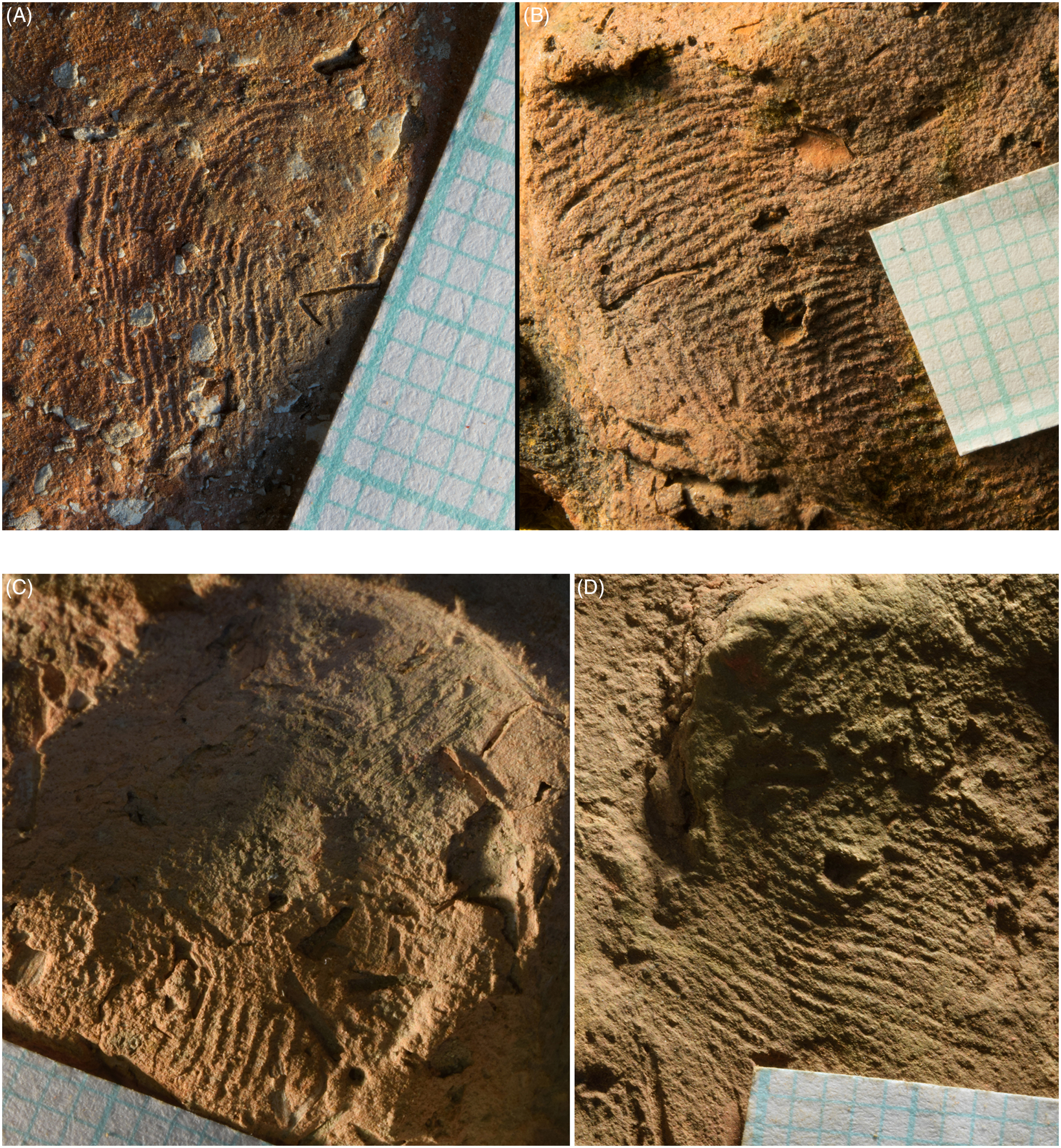
Fig. 7. Examples of fingerprints on briquetage: A. Spalding to Eye Road Improvement Scheme; B. Trunch Lane, Ingoldmells; C. Welland Bank Quarry; D. Tollesbury Red Hill
At the two Middle Iron Age Fenland sites, Helpringham (from which a radiocarbon determination of 380–110 cal bc (HAR-2280; 2180±80 bp) was recorded for timber from one of the hearths (Bell et al. Reference Bell, Gurney and Healey1999) and Langtoft (Lane Reference Lane2001), 14 of the 15 (93%) fingerprints were typical of adult males (n = 9, MRBs over 0.51 mm) or males over 16 years (n = 5, MRBs 0.457 mm and above), and one (at 0.458 mm) was highly consistent with an individual over 13 years (the adolescent/adult group).
During the 2nd century bc there is evidence for an intensification of salt production. Sites were located where local clay was silty and organic temper began to be used to improve thermal shock resistance, principally chaff from wheat, barley, and oats (de Brisay Reference de Brisay1978), presumably transported from further inland.
Three Late Iron Age Fenland sites (dated based on briquetage typology and associated pottery) produced 11 fingerprints: Spalding to Eye Road Improvement Scheme (Peachey et al. Reference Peachey, Failes and Bradley-Lovekin2011); Spalding Clay Lake site (Casswell Reference Casswell2011); and Willow Tree Fen (Cope-Faulkner Reference Cope-Faulkner2013). Two fingerprints at 0.473 mm and 0.499 mm MRB were highly consistent with males over 16 years and the other nine all exceeded 0.52 mm, so were typical of adult males.
Ormesby St Margaret was the only site studied from Norfolk and is currently the only known Iron Age saltern around the Great Estuary (Porter & Anderson Reference Porter and Anderson2017). Radiocarbon dates of 170–1 cal bc (SUERC 76905; 2064±24 bp) and 350–40 cal bc (SUERC 75961; 2121±35 bp; dates rounded out to 10 years) place its operation within the Middle–Late Iron Age. Five fingerprints were typical of adult males (n = 3, all exceeding 0.5 mm) or males over 16 years (n = 2, both over 0.48 mm), and one (0.445 mm) highly consistent with having been made by a person over 13 years, of either sex.
Four Late Iron Age saltern sites from the Lindsey Marshland were examined: three from the Ingoldmells area (unpublished) and one at Addlethorpe Northern Bypass (Cope-Faulkner Reference Cope-Faulkner2006), which collectively produced 33 fingerprints. Two were highly consistent with having come from individuals over 13 years (0.439 mm and 0.407 mm), two with males over 16 years (0.493 mm and 0.456 mm) and the remaining 29 were typical of adult males (MRBs over 0.51 mm).
Most pedestals bear curved impressions of trough edges as well as impressions of the manufacturer’s fingers and thumbs left as they were squeezed into shape. The widths of fingertip impressions can also be measured to assign an age to the person whose fingertips the impressions record (Sharpe & Van Gelder Reference Sharpe and Van Gelder2006a; Reference Sharpe and Van Gelder2006b; Laing Reference Laingin press). Figure 8 shows an example of an impression on a pedestal from Trunch Lane, Ingoldmells, whose width indicates it was made by an adult male thumb (Laing Reference Laing2021), which correlates with the epidermal ridge measurements within the print.

Fig. 8. Thumb impression on pedestal from Ingoldmells
The Late Iron Age Red Hills in Essex did not produce as many fingerprints as the Lincolnshire sites: ten from five sites: Osea Road (de Brisay Reference de Brisay1972; Reference de Brisay, de Brisay and Evans1975); Peldon (de Brisay Reference de Brisay1978); Goldhanger X (Reader Reference Reader1908); Langenhoe III (Rodwell Reference Rodwell, Burnham and Johnson1979); and Tollesbury (de Brisay Reference de Brisay1979). Nonetheless, the picture is similar with seven fingerprints typical of adult males (all over 0.543 mm), one (0.47 mm MRB) highly consistent with a male over 16 years, and two (at 0.43 mm and 0.44 mm MRBs) in the adolescent/adult category.
DISCUSSION
The similarity of Late Bronze and Early Iron Age briquetage to domestic pottery has been used to suggest earlier briquetage was made by women (Morris Reference Morris, Haselgrove and Moore2007), based on Peacock’s (Reference Peacock, Howard and Morris1981) ‘modes of production’ in which he used certain ethnographic examples to show that hand-made open fired pottery for everyday use was made by women, whereas men controlled production when it reached an industrial level. Lane (Reference Lane2017) argues the early salt makers were integrated into a community which included potters as their briquetage was nicely made and well-finished. In contrast, the Late Iron Age saw intensified production with sites located away from settlements and the standard of manufacture declining. Following Peacock (Reference Peacock, Howard and Morris1981), Morris (Reference Morris, Haselgrove and Moore2007) suggests that men controlled its production. However, Peacock’s ideas may be criticised for viewing men as industrial workers and women as unskilled domestic producers. More recent ethnographic studies have shown greater variety among salt producers: at Kibiro in Uganda salt production is an hereditary, female occupation (Connah et al. Reference Connah, Kamuhangire and Piper1990), all community members are involved at Teguidda-n’Tessum in Niger, whereas men are the salt makers in New Guinea (Gouletquer & Weller Reference Gouletquer, Weller, Brigand and Weller2015).
In this study, fingerprints were primarily preserved on pedestals and on pieces of clay used to support the troughs which contained the brine. Trough fragments in the assemblages studied did not generally preserve prints (although there were a few exceptions, namely the Middle Iron Age salterns at Helpringham Fen and Langtoft and the Late Iron sites at Tollesbury and Langenhoe). This could mean troughs were made by potters skilled in surface finishing, either on site or made elsewhere and brought to the salterns for use by the salt workers. Supports were made in situ as required by the saltern operators from local clays (Rodwell Reference Rodwell, Burnham and Johnson1979) and it is these which preserve predominantly late teenage and adult male prints.
Fingerprint evidence cannot tell us about all aspects of the process and it may be that other parts were carried out by women and children as well as men. This might include gathering fuel, clay, or sea water – all archaeologically invisible activities. However, the preponderance of male prints on the briquetage pedestals and supports indicates that the on-site ceramic manufacture, boiling, and salt extraction parts of the process were the preserve of men.
Accepting that pedestals and supports for the troughs were made in situ at the salterns by those working on the sites (Thomas & Fletcher Reference Thomas, Fletcher, Ellis, Fenwick, Lillie and Van Der Noort2001), it is reasonable to hypothesise that operation of the salt making process (boiling the brine and extracting salt crystals) during the Middle and Late Iron Age was performed by a selective male-dominated community of practice to which membership was limited by age and sex. Younger children were not involved in making equipment for salt extraction and induction into a community of salt makers may have been a rite of passage for young men in the Iron Age. This makes an interesting contrast to the Hallstatt salt mines in which men, women, and children were all involved in salt mining (Pany & Teschler-Nicola Reference Pany and Teschler-Nicola2007; Pany-Kucera et al. Reference Pany-Kucera, Reschreiter and Kern2010). It supports the idea that industrial scale salt making, as practised in the Late Iron Age, was the preserve of adult men (Morris Reference Morris, Haselgrove and Moore2007) but also indicates that men were the salt makers in the Middle Iron Age too.
Epidermal ridges reach adult dimensions around 15–16 years. If the results consistent with the maker of the print being males of 16 years and above are added to those of adult males then, excluding the earlier print from Welland Bank Quarry as a chronological outlier, the pattern is clear: during the Middle and Late Iron Age the fingerprints found on briquetage are almost exclusively from adult males. Given that there was just one print from the earlier Welland site it is impossible to draw conclusions about the changing make-up of the earlier briquetage producing communities of practice but further examination of assemblages of this date may reveal evidence of other younger hands at work, allowing discussion of the changing composition of salt making communities over time.
In Essex and Lincolnshire the lack of evidence for domestic occupation at saltern sites combined with a consideration of the British climate has led to suggestions that salt making was a seasonal activity, taking place in late summer after the harvest (de Brisay Reference de Brisay1978; Morris Reference Morris, Haselgrove and Moore2007; Biddulph Reference Biddulph, Foreman, Stafford, Stansbie and Nicholson2012). The addition of chaff, a by-product of cereal harvesting, as a tempering agent in later briquetage supports this (Percival Reference Percival2011). The lack of occupation debris may be functional, reflecting the difficulty of year-round occupation of exposed sites in the saltmarsh away from fresh water supplies, or may reflect social controls on times and individuals permitted access to the sites. Given the assumed value of salt to Iron Age communities, and possible social controls over the operation of the extraction process, the apparent lack of any enclosing or defensive structures around salterns is interesting (Kinory Reference Kinory2012).
Communities of salt workers may have been viewed as especially skilled or socially distinct people, creating a valuable new material from water at liminal locations. If, as the results of this study suggest, salt working at coastal locations was carried out by groups of teenage and adult males, this raises further questions around the status of these relatively transient communities of practice.
CONCLUSIONS
During the Middle and Late Iron Age in eastern England salt extraction was carried out at the end of the summer in coastal marshes lacking permanent habitation. A picture emerges of a gendered and age-specific activity in which the participants were temporarily separated from their communities, perhaps with younger adolescents being inducted into the practices of salt extraction once they had reached a culturally accepted level of maturity. The inclusion of adolescent males within the salt making communities of practice suggests biological adolescents may have been culturally viewed as adults at this period.
The technique of interpreting age and possibly sex of a maker of a fingerprint by measuring the breadth of the epidermal ridges has wider application within archaeology. Modern reference data reflecting as far as possible the geographical locale of those whose fingerprints are being studied is important, as is allowing for height differences between modern and ancient people, given the correlation between height and MRB. Provided the modern reference collection data is adjusted to reflect height differences in the period under study, there is great potential to shed light on demography among communities of practice engaged in ceramic manufacture.
Acknowledgements
The PhD research on which this article is based was funded initially by the University of Leicester, and subsequently by the AHRC Midlands 4 Cities Doctoral Training Partnership. I am grateful to my PhD supervisors Prof Colin Haselgrove and Dr Jo Appleby for their support throughout my doctoral research and to Dr Elaine Morris for her helpful comments on an earlier draft of this article.





